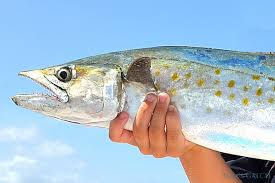Spanish mackerel: Everything you need to know
- pescatoreseafoodus
- Oct 19, 2023
- 3 min read
Updated: Nov 16, 2023

Within our product line we include the Spanish mackerel. Today we are going to tell you some interesting facts that you may not have known about this incredible marine species.
The Spanish mackerel is much smaller than its relative, the king mackerel, averaging only 2 to 3 pounds in weight. Spanish mackerel are greenish dorsally with silver sides and bellies. Yellow or olive oval spots traverse the body, which is covered with very tiny scales. The lateral line curves gently to the base of the tail.
Spanish mackerel form immense, fast-moving schools that are distributed from New York to Mexico, preferring water temperatures above 68° F. Unlike king mackerel, Spanish mackerel do not appear to move freely around the Florida Keys, creating two subpopulations, one in the Gulf and the other off the southeastern states. Spanish mackerel are fast-growing and may live to be 8 years old. Both sexes are capable of reproduction by the second year. Spawning occurs from April to September off the North Carolina and Virginia coasts. Feeding Spanish mackerel are often seen forcing schools of small fish into tight bundles and nearly pushing them out of the water.
SIZE AND WEIGHT
Spanish mackerel are commonly caught weighing between 2 – 15kg and 55 – 125cm long. However, they can grow up to 40kg in weight and over 200cm long.
Local fishing authorities heavily regulate Spanish mackerel in both commercial and regulation fisheries. This species is under significant Government assessment and regulation reform that will see commercial quotas and recreational bag limits decrease to protect the species for the future.
WHEN AND WHERE TO FIND THEM
Spanish mackerel migrate along the Australian coastline following the warm waters of the East Australian Current south during summer and autumn in search of baitfish. They then return north as the waters cool before winter.
Spanish mackerel can be found in a range of habitats along the majority of Western Australia, Northern Territory, Queensland and northern New South Wales coastlines. Rock fisherman, kayaks, small trailer boats and large game fishing vessels can all target Spanish mackerel.
Spanish mackerel will be found anywhere you find bait throughout their distribution, from coastal waters just offshore out to the continental shelf. Depending on conditions they can be targeted with a range of techniques and will respond to a variety of fishing methods including trolling and casting lures, towing dead and live baits, anchored floating live and dead baits or casting from rocky headlands.
The medium sized fish up to 8kg will school up in the hundreds whilst larger fish form small packs or can be solitary. Spanish mackerel favour areas with structure and current that holds baitfish school around coral reef edges, reef bomboras, wrecks, rocky headlands and large drop offs.
Using your sounder can be very effective when fishing for Spanish mackerel as they mark up very distinctly on the screen allowing you to locate and mark these schools, then target the area using your preferred plan of attack.
HANDLING
Spanish mackerel have extremely large sharp teeth that will cut through an unsuspecting fisherman’s flesh like butter. Anglers who don’t know how to handle them correctly have been left with fingers cut to the bone, thighs sliced open and feet in a bloody mess.
The best method for landing a Spanish mackerel that is destined for the table is to gaff it in the head and then use a wooden bat to subdue the fish. You can then brain spike your fish and bleed it boat side before being placed immediately into an ice slurry to set the flesh. If the fish is left in the sun or on the deck the flesh will quickly deteriorate and become soft.
Releasing Spanish mackerel is certainly possible but best done beside the boat without handling the fish. A long armed hook remover is ideal to get the hooks out and keeps your fingers out of harm’s way. As the fish are hard to control, bringing one onto the boat alive will result in the fish kicking and slashing with its teeth which is likely to inflict damage on any body parts that get in the way, but it also removes the fish’s slime and scales reducing its survivability rate.
In areas where Spanish mackerel are abundant, they’re a staple food source for sharks which will hang off the edges of schooling fish. Each season many fish are eaten by sharks and they have worked out to follow the sound of the motors trolling around and wait for the Spanish mackerel to hook up before striking and taking their share of the catch.
COOKING YOUR CATCH
Spanish mackerel are an excellent eating fish, and the flesh freezes well. The only issue with this species is a chance of ciguatera poisoning accumulating in larger fish that are captured in tropical waters.
Shallow fried in breadcrumbs, simply coated in flour with salt and pepper, or cooked up in taco seasoning, Spanish mackerel are a tasty treat that is worth the effort of preparing for the plate.





Comments